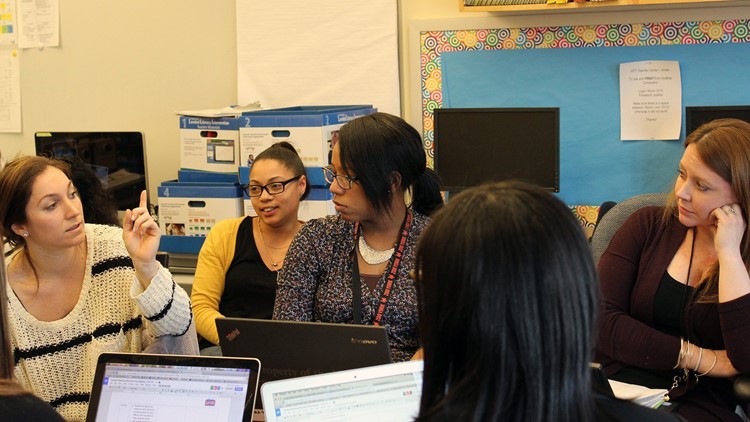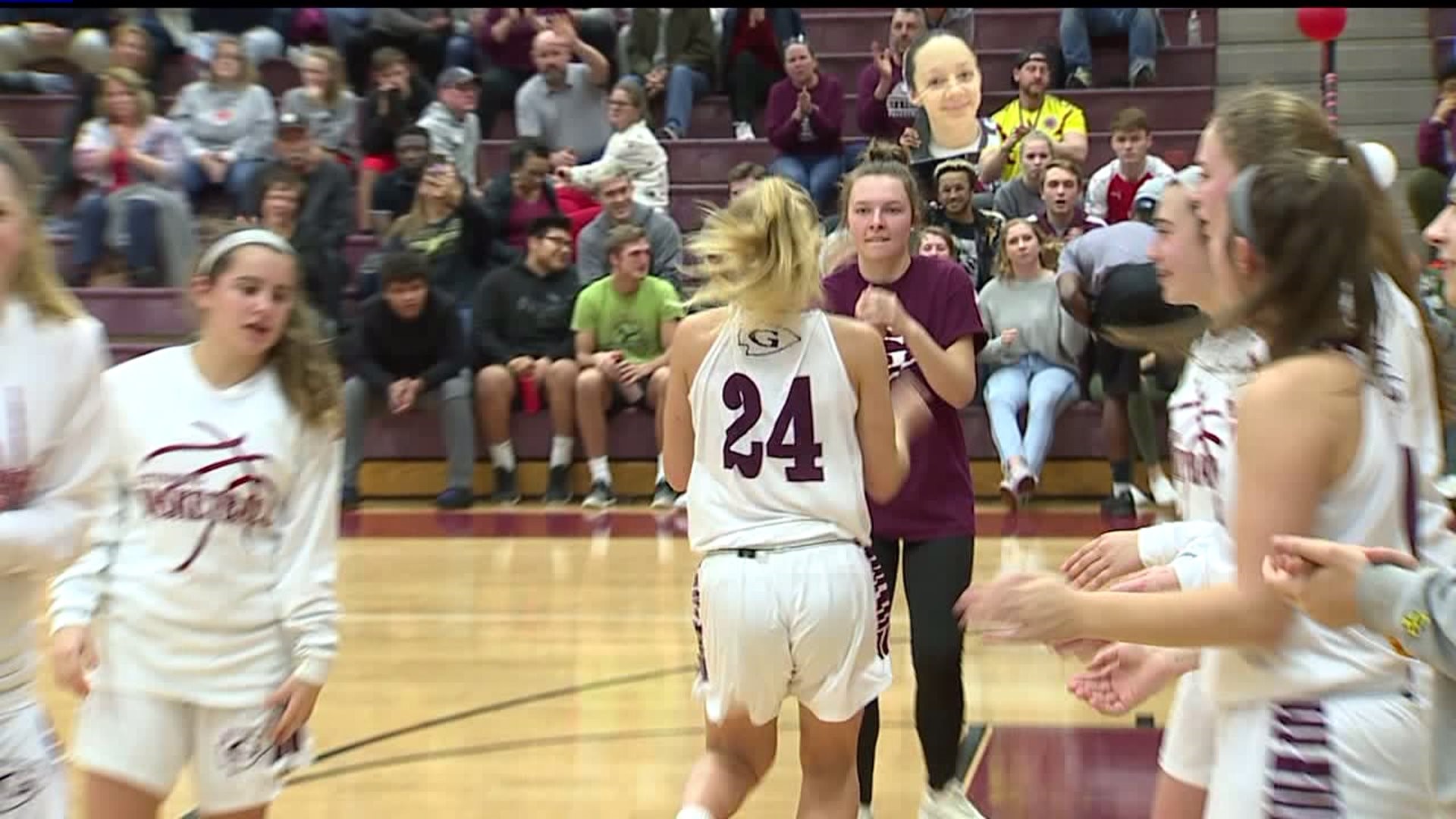A lifelong educator and advocate for children, Principal Diane Daprocida of P.S. 94, an elementary school in the Bronx, says she has been waiting for one thing since she started running the school 10 years ago.
You might guess it’s more money or resources, or smaller class sizes, but something else topped her wish list: a way to teach her teachers, many of whom have four years or less of teaching experience, how to teach reading.
“Our universities do not teach teachers how to (teach reading) at the undergraduate level,” Daprocida said. “It’s philosophy of education, sociology of education, classroom management. I mean, I can’t even remember. It’s been so long since I’ve been to school, but they are coming through a traditional track not knowing how to teach reading, just the overall basic components of it.”
As principal of a high-needs urban school with 1,260 students, up from 830 six years ago, she more than has her hands full just trying to keep her students and her 130 teachers on track. But she also is faced with narrowing a stunning word deficit: Children living in poverty hear 30 million fewer words by age 4 than children in higher-income households, according to researchers.
It’s a struggle across the country. Reading scores on the 2015 National Assessment of Educational Progress, known as the Nation’s Report Card, were steady for fourth graders since 2013, while reading scores for eighth graders declined. Additional 2015 NAEP results released this week showed that 12th grade students’ reading scores remained flat since 2013. Thirty-seven percent of high school seniors performed at or above the “proficient” level in reading.
Daprocida said she and her colleagues have tried different approaches to improve reading levels, but nothing was moving the students.
Then, two years ago, she collaborated with Teaching Matters, an organization that works to develop and retain great teachers in some of the highest-needs districts in New York.
“The reason I partnered with them is because I had so many new teachers, and we saw the difference immediately in the type of professional support that they provided for us.”
But it wasn’t until last year that she truly got her wish: Thanks to a $600,000 grant from the New York Community Trust Brooke Astor Fund for New York City Education, Teaching Matters brought its program to improve reading instruction in early grades to eight high-poverty schools in the Bronx, including P.S. 94.
“It’s like going for a master’s in reading,” said Daprocida, who taught special education for 10 years before coming to P.S. 94. “If you really buy into it and you use the resources, it’s getting a master’s in reading.”
Following the research of reading instruction
During a recent visit to P.S. 94, I had a chance to see some of what the Teaching Matters focus on early reading is bringing to Daprocida and her colleagues.
In each classroom, small groups of children work independently: In kindergarten, a table captain might say the sound of the beginning of a word while the other students write the letter on their smart boards. In second grade, students play the game Hedbanz, in which one person wears a headband with a word they can’t see and gets clues from the other students to try to guess the word. In third grade, three boys read “Paul Bunyan,” with each reading the text attributed to a different character.
In addition to these independent work stations, teachers lead small groups of students in guided reading instruction. In kindergarten, a teacher and students discuss a book about feathers and what clues they have to know that the book is not about birds. In third grade, students reading “Behind Rebel Lines,” a book about a Civil War spy, discuss the motivations of the people they are reading about.
This focused approach, which includes leading and encouraging students to think in more complex ways about the books they are reading, is based on bringing together all the existing research on teaching vocabulary, comprehension and guided reading, and coming up with a program that works, said Naomi Cooperman, senior director of new content and evaluation for Teaching Matters.
“We’ve really done a lot of research in terms of what makes sense in terms of reading instruction,” said Cooperman. “It’s not quirky. It’s not like sort of one philosophy. It pulls together the kinds of strategies that researchers are telling us are powerful.”
This research doesn’t always filter down into the schools, she said. “The academics are sitting here, and they’re writing the articles, and the schools are just often purchasing curriculum programs, but they’re not seeing the links … and our job is to help them make those links and see the strategies that are underneath it all.”
Those strategies, in the form of an online toolkit filled with easy to understand templates such as “What a Guided Lesson Should Contain,” are made available through the Teaching Matters website to teachers and school leaders supported by the organization.
Another core part of the Teaching Matters program is providing coaching, in the form of highly skilled and trained individuals who visit the school weekly and become a go-to resource for the principal and teachers.
“Our work happens on many different levels,” said Michelle Macchia, the coach assigned to P.S. 94. “It’s not just showing up and giving a workshop, and then we’re gone. It’s weekly visits to the schools to help in any way possible, any way needed to support teachers, but also we do a great deal of support for our school leaders and for our budding teacher leaders.”
Part of what Teaching Matters tries to do is change the culture, said Macchia, a senior educational consultant at Teaching Matters.
“The olden days of professional development for teachers was … someone coming in to deliver a workshop, ‘Here goes your folder. Bye,’ ” Macchia said, using a monotone voice to drive home her point. “This is a relationship … a relationship of trust where teachers know that they can say, ‘Hey, Michelle … what time are you free today, because I need to talk to you about something?’
“So I go in, we talk, we plan, we bounce ideas off of each other, and it’s really that type of on-the-job professional development that brings teachers together and shows them how to collaborate and then go back to the classrooms and try things and then come back and say ‘it flopped’ or ‘it was a huge success.’ … That’s different from what has been done in the past.”
Alyssa Ciccone, a first-grade special education teacher who is in her second year of teaching, said the coaching has been particularly beneficial.
“It really has helped me tremendously, because in college, they don’t really teach you how to do guided reading. That’s not on the top of their priority list, so when I came in here, I was kind of clueless, and Michelle really helped us out with all the guided reading templates and everything,” Ciccone said. “It really made me see it. I need visuals, also. That’s how I learn, and I saw the visuals, and I got it.”
Teachers are also learning from each other at P.S. 94. Every six to eight weeks, teachers sit in a class as another does a guided reading lesson. After the lesson, they discuss what worked and what didn’t.
“Everyone has a different rate of learning. Some teachers learn faster than others, so the ones that learned faster became the models for the other teachers who were learning the ropes,” said Daprocida.
Jestiny Roig, a first-grade general education teacher, said these visits have definitely helped in her classroom.
“I really need to see it, like, ‘Oh, I need to do it like that,’ and get ideas from other people, because it’s one thing to say it, but if you see it done, then you’ll apply it.”
Third-graders reading fifth-grade books
One year in, have Daprocida and her colleagues finally been able to move students’ reading scores? Both anecdotal evidence and an assessment by an external evaluator say the answer is a resounding yes.
“Where you see the biggest bang right now is third grade,” Daprocida said. “They’re reading books that my fifth-graders were reading.”
In the past, one or two students might be reading fifth-grade level books in the third grade, books such as “Shiloh” or “The Family Underneath the Bridge.”
Now, “we’ve got third-grade kids across the board … reading those stories and being able to discuss the plot of those books, and it’s just amazing,” she said.
She’s also seen an impact in the lower grades, again based on what books they can and want to read.
“I’ve had to buy a ton of new books because they read through everything. Second grade got into third grade; they’d already read through everything, so third grade needed all new books to begin with, and the first grade going into second grade, second grade needed all new books because they’d blown through everything second grade last year by the end of first grade.”
Deirdre Kehayas, the United Federation of Teachers teacher center coach at P.S. 94, says she has had first-grade teachers nearly knocking down her door, telling her, “I need level M and N books. I don’t have them. These kids are getting sick of reading the same books over and over again.”
She has seen firsthand how much the children are growing because of how much is being addressed in the guided reading lessons. “It looks very different, even from when I was a teacher, when I taught guided reading. It’s just so much more now, and it makes sense.”
The numbers, based on an independent evaluator, reflect what Daprocida and her colleagues are seeing informally. Just about 25% of first-, second- and third-graders in the eight schools incorporating the Teaching Matters early reading program were reading at grade level at the start of the year, according to Daniel Long of Research for Action, an independent evaluation consulting firm focused on education policy and education intervention.
That number jumped to 38% in the middle of the year, he said.
At P.S. 94, about 30% of third-grade students are typically reading at grade level by the mid-year assessment, according to Daprocida. Now, more than half of third-graders are, according to Long.
“We never had that before,” Daprocida said. “It’s just really exciting for us, because what they learned last year has enabled them to stop learning how to read and use reading to learn.”
Daprocida said her school’s story shows that the major obstacle to success wasn’t the income level of students’ families or the amount of English spoken at home. It all comes down to the art of teaching reading, she said.
“The focus isn’t on the fact that these kids are really at a deficit in terms of finances, in terms of living circumstances,” she said. Instead, it was the skill level “to be able to teach reading, and that’s what we needed to bring to our teachers, and that’s what we’ve been able to do.”



